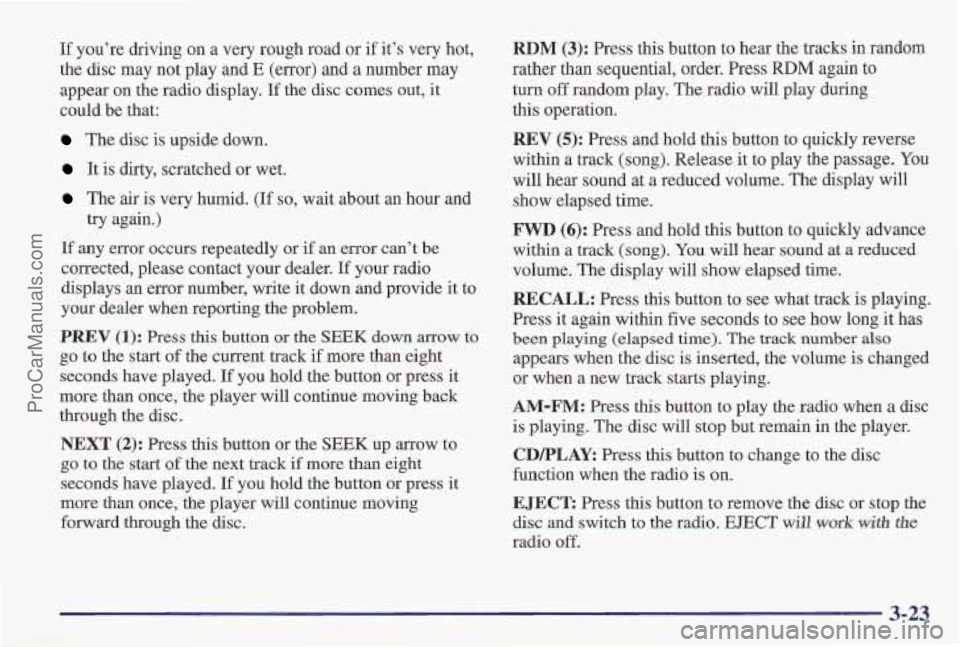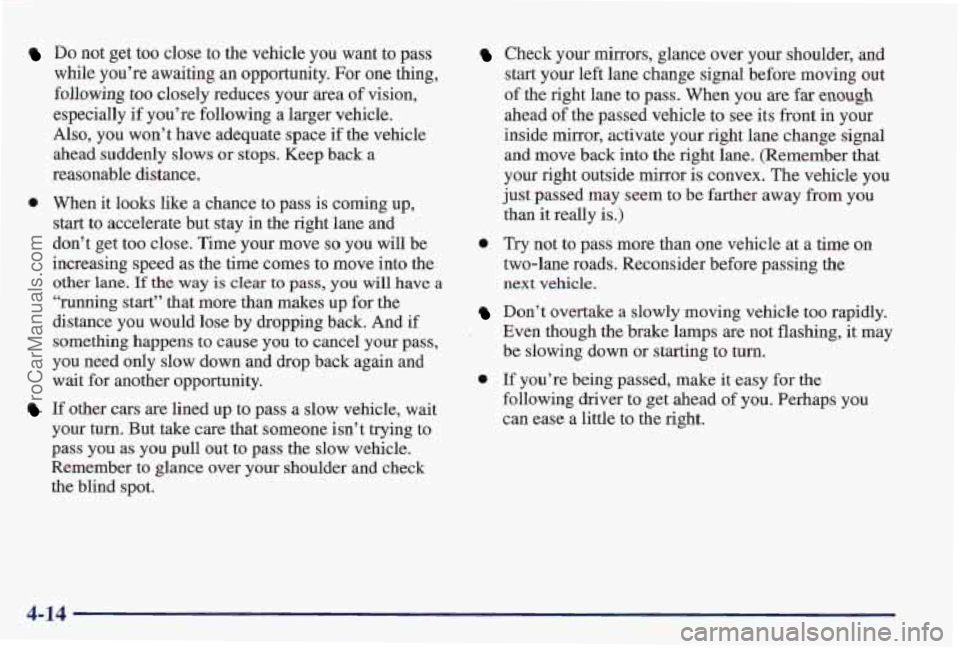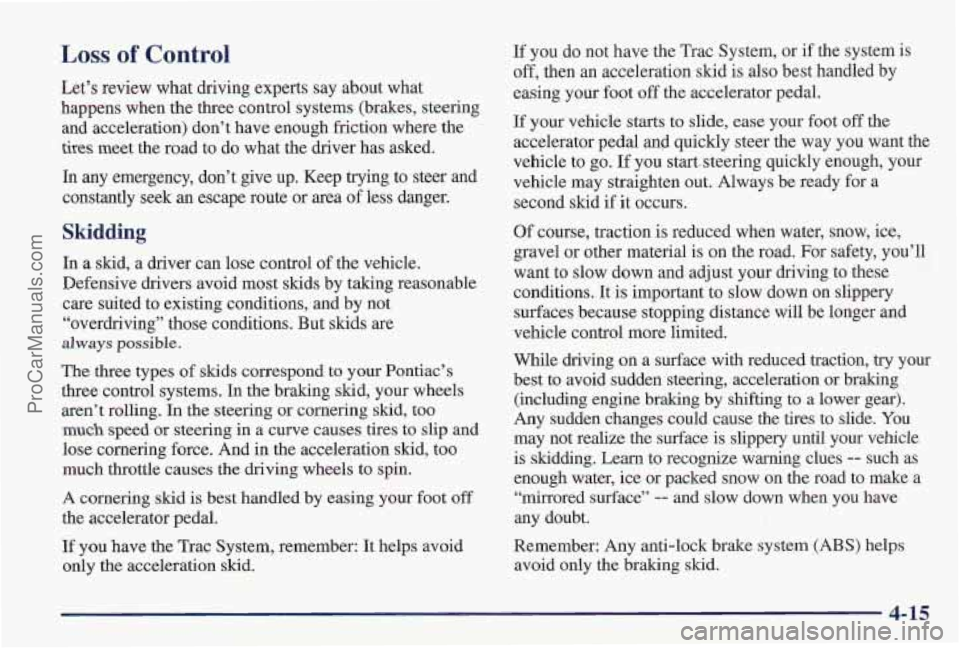1997 PONTIAC PONTIAC stop start
[x] Cancel search: stop startPage 145 of 419

NOTICE:
If you keep driving your vehicle with this light
on, after a while, your emission controls may not
work as well, your fuel economy may not be as
good and your engine may not run as smoothly.
This could lead to costly repairs that may not be
covered by your warranty.
This light should come on, as a check to show you it is
working, when the ignition
is on and the engine is not
running.
If the light doesn’t come on, have it repaired.
This light will also come on during a malfunction in one
of two ways:
0 Light Flashing -- A misfire condition has been
detected.
A misfire increases vehicle emissions and
may damage the emission control system on your
vehicle. Dealer
or qualified service center diagnosis
and service is required.
Light On Steady -- An emission control system
malfunction has been detected on your vehicle.
Dealer or qualified service center diagnosis and
service
may be required.
If the Light Is Flashing
The following may prevent more serious damage to
your vehicle:
Reducing vehicle speed.
Avoiding hard accelerations.
Avoiding steep uphill grades.
If you are towing a trailer, reduce the amount of
cargo being hauled as
soon as it is possible.
If the light stops flashing and remains on steady, see “If
the Light
Is On Steady” following.
If the light continues to flash, when it is safe to do
so,
stop the vehicle. Find a safe place to park your vehicle.
Turn the key off, wait at least 10 seconds and restart the
engine.
If the light remains on steady, see “If the Light
Is On Steady” following. If the light is still flashing,
follow the previous steps, and drive the vehicle to your
dealer or qualified service center for service.
2-71
ProCarManuals.com
Page 147 of 419

Oil Warning Light
If you have a problem with
your oil pressure, this light
may stay on after you start
your engine, or come on
when you are driving.
This indicates that oil is not going through your engine
quickly enough to keep it lubricated. The engine could
be low on oil or could have some other
oil problem.
Have it fixed right away.
The
oil light could also come on in two other situations:
0 When the ignition is on but the engine is not running,
the light will come on as a test to show you it is
working, but the light will
go out when you turn the
ignition to
START. If it doesn’t come on with the
ignition
on, you may have a problem with the fuse or
bulb. Have it fixed right away.
If you make a hard stop, the light may come on for a
moment.
This is normal.
Don’t keep driving if the oil pressure is low. If
you do, your engine can become so hot that it
catches fire. You or others could be burned.
Check your oil as soon
as possible and have your
vehicle serviced.
NOTICE:
Damage to your engine from neglected oil
problems can be costly and
is not covered by
your warranty.
2-73
ProCarManuals.com
Page 159 of 419

To adjust the HUD so you can see it properly:
1. Start your engine and turn the DIM dial to the
desired HUD image brightness.
2. Adjust your seat, if necessary, to a Comfortable position.
3. Press the top of the UPDN switch until the HUD image
stops moving. Then press the bottom
of the switch until
~e image is as low as possible but in full view.
brighter than necessary.
To turn the HUD off, turn
the DIM dial all the way down.
4. Turn the DIM dial down until the HUD image is no
If the sun comes out, it becomes cloudy, or if you turn
on your headlamps, you may need
to adjust the HUD
brightness again. Polarizing sunglasses could make the
HUD image harder to see.
If the HUD image is too bright, or too high in
your field
of view, it may take you more time to
see things you need to see when it’s dark outside.
Be sure to keep the
HUD image dim and placed
low in your field
of view.
Push the ENG/MET button
on
the trip calculator to
switch the HUD speed
display from English to
metric or metric to English.
If you don’t have the trip
calculator,
you can’t change
the display.
2-85
ProCarManuals.com
Page 181 of 419

RDM (3): Press this button to hear the tracks in random,
rather than sequential, order. Press
RDM again to turn
off random play.
AM-FM Stereo with Compact Disc Player
and Equalizer
(If Equipped)
REV (5): Press and hold this button to quickly reverse
within
a track (song). Release it to play the passage. You
will hear sound at a reduced volume. The display will
show elapsed time.
FWD (6): Press and hold this button to quickly advance
within a track (song). You will hear sound at a reduced
volume. The display will sh'ow elapsed time.
RECALL: Press this button to see what track is playing.
Press it again within five seconds to see how long it has
been playing (elapsed time). The track number also
appears when the disc is inserted, you change the
volume or when a new track starts playing.
AM-FM: Press this button to play the radio when a disc
is playing. The disc will stop but remain in the player.
CDPLAY: Press this button to change to the disc
function when the radio
is on.
EJECT: Press this button to remove the disc or stop the
disc and switch to the radio.
EJECT will work with the
radio
off. Playing
the Radio
VOL: Push
this knob to turn the system on and off.
To increase volume, turn
the knob clockwise. Turn it
counterclockwise to decrease volume.
RECALL: Press this button briefly to recall the station
being played or to display
the clock. If you press the
knob when the ignition is
off, the clock will show for a
few seconds.
3-21
ProCarManuals.com
Page 183 of 419

If you’re driving on a very rough road or if it’s very hot,
the disc may not play and
E (error) and a number may
appear on the radio display.
If the disc comes out, it
could be that:
The disc is upside down.
It is dirty, scratched or wet.
The air is very humid. (If so, wait about an hour and
If any error occurs repeatedly or if an error can’t be
corrected, please contact your dealer.
If your radio
displays an error number, write it down and provide it to
your dealer when reporting the problem.
PREV (1): Press this button or the SEEK down arrow to
go to the start of the current track if more than eight
seconds have played. If you hold the button or press it
more than once, the player will continue moving back
through the disc.
NEXT (2): Press this button or the SEEK up arrow to
go to the start of the next track if more than eight
seconds have played. If you hold the button or press it
more than once,
the player will continue moving
forward through the disc, try again.)
RDM (3): Press
this button to hear the tracks in random
rather than sequential, order. Press
RDM again to
turn off random play. The radio will play during
this operation.
REV (5): Press and hold this button to quickly reverse
within a track (song). Release it to play the passage, You
will hear sound at a reduced volume. The display will
show elapsed time.
FWD (6): Press and hold this button to quickly advance
within a track (song). You will hear sound at a reduced
volume. The display will show elapsed time.
RECALL: Press this button to see what track is playing.
Press it again within five seconds to see how long it has
been playing (elapsed time). The track number
also
appears when the disc is inserted, the volume is changed
or when
a new track starts playing.
AM-FM: Press this button to play the radio when a disc
is playing. The disc will stop but remain in the player.
CD/PLAY: Press this button to change to the disc
function when the radio is on.
EJECT Press this button to remove the disc or stop the
disc and switch to the radio.
EJECT will work with the
radio off.
3-23
ProCarManuals.com
Page 201 of 419

Avoid needless heavy braking. Some people drive in
spurts
-- heavy acceleration followed by heavy
braking
-- rather than keeping pace with traffic. This is a
mistake. Your brakes may not have time to cool between
hard stops. Your brakes will wear out much faster if you
do a lot of heavy braking. If you keep pace with the
traffic and allow realistic following distances, you will
eliminate a lot of unnecessary braking. That means
better braking and longer brake life.
If
your engine ever stops while you’re driving, brake
normally but don’t pump your brakes.
If you do, the
pedal may get harder to push down.
If your engine
stops, you will still have some power brake assist. But
you
will use it when you brake. Once the power assist is
used up, it may take longer to stop and the brake pedal
will be harder to push.
Anti-Lock Brakes (ABS)
Your vehicle has anti-lock brakes (ABS). ABS is an
advanced electronic braking system that will help
prevent a braking skid.
When you start your engine, or when you
begin to drive
away, your anti-lock brake system will check itself. You
may hear a momentary motor or clicking noise while
this test is going on, and you may even notice that your
brake pedal moves a little. This is normal.
If there’s a problem with the
anti-lock brake system, this
warning light will stay on or
flash. See “Anti-Lock
Brake System Warning
Light” in the Index.
4-7
ProCarManuals.com
Page 208 of 419

Do not get too close to the vehicle you want to pass
while you’re awaiting
an opportunity. For one thing,
following too closely reduces your area of vision,
especially if you’re following a larger vehicle.
Also, you won’t have adequate space if the vehicle
ahead suddenly slows or stops. Keep back a
reasonable distance.
0 When it looks like a chance to pass is coming up,
start to accelerate but stay in the right l’ane and
don’t get too close. Time your move
so you will be
increasing speed as the time comes to move into the
other lane. If the way is clear to pass, you will have a
“running start’’ that more than makes up for
the
distance you would lose by dropping back. And if
something happens to cause
you to cancel your pass,
you need only slow down and
drop back again and
wait for another opportunity.
If other cars are lined up to pass a slow vehicle, wait
your turn. But take care that someone isn’t trying to
pass you as you pull out to pass
the slow vehicle.
Remember to glance over your shoulder and check
the blind spot.
Check your mirrors, glance over your shoulder, and
start your left lane change signal before moving out
of the right lane to pass. When you are far enough
ahead of the passed vehicle to see its front in your
inside mirror, activate your right lane change signal
and move back into the right lane. (Remember that
your right outside mirror is convex. The vehicle you
just passed may seem to
be farther away from you
than it really is.)
0 Try not to pass more than one vehicle at a time on
two-lane roads, Reconsider before passing the
next vehicle.
Don’t overtake a 8slowly moving vehicle too rapidly.
, Even though the brake lamps are not flashing, it may
be slowing down or starting to turn.
0 If you’re being passed, make it easy for the
following driver to get ahead of you, Perhaps you
can ease
a little to the right.
4-14
ProCarManuals.com
Page 209 of 419

Loss of Control
Let’s review what driving experts say about what
happens when the three control systems (brakes, steering
and acceleration) don’t have enough friction where the
tires meet the road to do what the driver has asked.
In any emergency, don’t give up. Keep trying to steer and
constantly seek an escape route or area of less danger.
Skidding
In a skid, a driver can lose control of the vehicle.
Defensive drivers avoid most skids by taking reasonable
care suited to existing conditions, and by not
“overdriving” those conditions. But skids are
always possible.
The three types of skids correspond to your Pontiac’s
three control systems. In the braking skid, your wheels
aren’t rolling. In the steering or cornering
skid, too
much speed or steering in a curve causes tires to slip and
lose cornering force. And in the acceleration skid, too
much throttle causes the driving wheels to spin.
A cornering
skid is best handled by easing your foot off
the accelerator pedal.
If you have the Trac System, remember: It helps avoid
only the acceleration skid. If
you do not have the Trac System, or if the system is
off, then an acceleration skid is also best handled by
easing your foot off
the accelerator pedal.
If your vehicle starts to slide, ease your foot off the
accelerator pedal and quickly steer the way you want the
vehicle to go.
If you start..steering quickly enough, your
vehicle may straighten out. Always be ready for a
second slud
if it occurs.
Of course, traction is reduced when water, snow, ice,
gravel or other material
is on the road. For safety, you’ll
want to slow down and adjust your driving to these
conditions. It
is important to slow down on slippery
surfaces because stopping distance will be longer and
vehicle control more limited.
While driving on a surface with reduced traction,
try your
best to avoid sudden steering, acceleration or braking
(including engine braking by shifting
to a lower gear).
Any sudden changes could cause the tires to slide. You
may not realize the surface is slippery until your vehicle
is skidding. Learn to recognize warning clues -- such as
enough water, ice or packed snow on
the road to make a
“mirrored surface”
-- and slow down when you have
any doubt.
Remember: Any anti-lock brake system (ABS) helps
avoid only the braking skid.
4-15
ProCarManuals.com